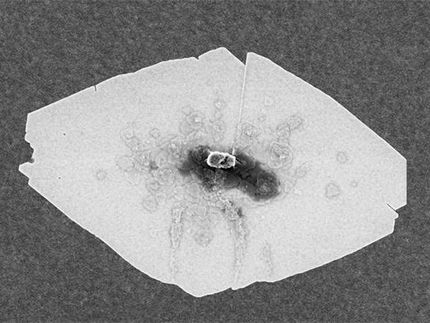Nanobandages - Successful control of bleeding by closing vena cava wound with nanosheets
Severe damage to the large vessels from multiple trauma or accidental complications in surgery can cause exsanguinating hemorrhage leading to death. Especially in the thin-walled vena cava abundant with blood, a tear in a small laceration soon widens, requiring a difficult and specialized vascular surgery technique to be fixed. We developed nano-adhesive plasters that can easily be applied to lacerated vessel walls with no adhesive, and succeeded in arresting massive bleeding from the inferior vena cava in rabbits.
A research group from the National Defense Medical College, in joint research with the Waseda University Graduate School of Advanced Science and Engineering, has developed nano-thickness sheets (1/100000~1/10000 mm) about the same thinness as cell membranes. These pellicle sheets are so-called “nanosheets” that can be perfectly attached, with no gaps, to the organ or tissue surfaces with no adhesive. In a world first, by applying these nanosheets, massive hemorrhaging from thin-walled large vessels such as the vena cava can be arrested. These results recently published in the Journal of Vascular Surgery.
Nanosheets are tightly attached to the surface of any organ and skin with no adhesive, and furthermore, cause no adhesion. Because the nanosheets are transparent, the control of the bleeding can be clearly seen in addition to being able to overlap multiple nanosheets when there is insufficient arrest of the bleeding. A 7 mm incision to a rabbit’s inferior vena cava can be fatal, but by applying nanosheets to the bleeding area, we succeeded in quick hemostasis in all the rabbits (wounds to the lungs, digestive tract and the brain’s arachnoid membrane can also be simply covered by applying nanosheets). We hope that nanosheets, which can simply stop bleeding of large vessels without using complicated surgical techniques such as vascular suture, will become considerably useful for effective hemostasis not only in the surgical patients receiving major operations but also in the trauma victims with massive hemorrhage.
Original publication
Effective control of massive venous bleeding by “multi-overlapping therapy” using polysaccharide nanosheets in a rabbit inferior vena cava injury model, Journal of Vascular Surgery, May 17 online version, and in print in the June Vol. 1 No. 3 version
Most read news
Original publication
Effective control of massive venous bleeding by “multi-overlapping therapy” using polysaccharide nanosheets in a rabbit inferior vena cava injury model, Journal of Vascular Surgery, May 17 online version, and in print in the June Vol. 1 No. 3 version
Organizations
Other news from the department research and development

Get the life science industry in your inbox
By submitting this form you agree that LUMITOS AG will send you the newsletter(s) selected above by email. Your data will not be passed on to third parties. Your data will be stored and processed in accordance with our data protection regulations. LUMITOS may contact you by email for the purpose of advertising or market and opinion surveys. You can revoke your consent at any time without giving reasons to LUMITOS AG, Ernst-Augustin-Str. 2, 12489 Berlin, Germany or by e-mail at revoke@lumitos.com with effect for the future. In addition, each email contains a link to unsubscribe from the corresponding newsletter.




















































